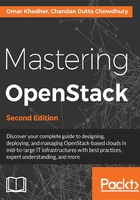
Cinder - block storage
You may wonder whether there is another way to provide storage to OpenStack users. Indeed, the management of the persistent block storage is available in OpenStack by using the Cinder service. Its main capability is to provide block-level storage to the virtual machine. Cinder provides raw volumes that can be used as hard disks in virtual machines.
Some of the features that Cinder offers are as follows:
- Volume management: This allows the creation or deletion of a volume
- Snapshot management: This allows the creation or deletion of a snapshot of volumes
- Attaching or detaching volumes from instances
- Cloning volumes
- Creating volumes from snapshots
- Copy of images to volumes and vice versa
It is very important to keep in mind that like Keystone services, Cinder features can be delivered by orchestrating various backend volume providers through configurable drivers for the vendor's storage products such as from IBM, NetApp, Nexenta, and VMware.
Cinder is proven as an ideal solution or a replacement of the old nova-volume service that existed before the Folsom release on an architectural level. It is important to know that Cinder has organized and created a catalog of block-based storage devices with several differing characteristics. However, we must obviously consider the limitation of commodity storage such as redundancy and auto-scaling.
When Cinder was introduced in the OpenStack Grizzly release, a joint feature was implemented to allow creating backups for Cinder volumes. A common use case has seen Swift evolves as a storage backup solution. Within the next few releases, Cinder was enriched with more backup target stores such as NFS, Ceph, GlusterFS, POSIX file systems, and the property IBM solution, Tivoli Storage Manager. This great backup extensible feature is defined by the means of Cinder backup drivers that have become richer in every new release. Within the OpenStack Mitaka release, Cinder has shown its vast number of backup options by marrying two different cloud computing environments, bringing an additional backup driver targeting Google Cloud Platform. This exciting opportunity allows OpenStack operators to leverage an hybrid cloud backup solution that empowers , a disaster recovery strategy for persistent data. What about security? This latent issue has been resolved since the Kilo release so Cinder volumes can be encrypted before starting any backup operations.